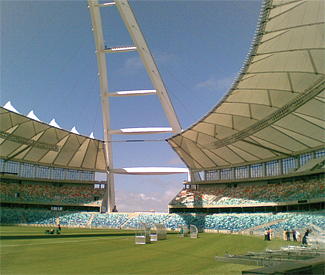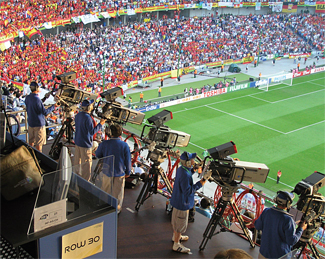World Cup Spans Media Landscape
JOHANNESBURG, SOUTH AFRICA
With an estimated worldwide viewership of 1.5 billion, the 2010 FIFA World Cup in Johannesburg, South Africa, June 11-July 12 will arguably be the world’s largest sports broadcast in history.

Photo: Rob Tringali, ESPN The greatest challenge broadcasters face is providing all 64 matches from this quadrennial men’s soccer event without any technical glitches. Broadcasters face complex logistics because some of the 10 venues are almost a day’s drive from Johannesburg.
“Our goal is to provide broadcasters with more production support than we did for the 2006 FIFA World Cup in Germany to make it easier for them to present this event with exceptional quality,” said Francis Tellier, founding chief executive officer of France-based HBS (Host Broadcast Services), the exclusive host broadcaster for this event since 1998. “We’re extremely proud that our service includes a full turnkey presentation available to every country in the world, complete with commentary, graphics, and local color about each team and its unique story.”
Forty ENG crews, 34 of which are dedicated to following the qualifying teams, will produce the content. And it will be available to all rights holders, called “Media Rights Licensees” (MRLs) from a media server at the International Broadcast Center (IBC) in Johannesburg, South Africa.
GRAND EXPERIMENT
“The big buzz this year is our ‘grand experiment’ to present 25 of the matches in true 3D HD for broadcast on a special channel being launched by ESPN for U.S. viewers,” Tellier said. “Live 3D HD broadcasts will also be available in Japan. Beyond these two markets, live 3D HD will only be available at digital cinemas world-wide that have 3D projection, a satellite dish or fiber connection, and the rights.” (Editor’s note: at presstime, satellite provider Aruna Media AG no longer had the rights to deliver World Cup content to public venues overseas; FIFA has since retained the rights.)
HBS will also offer a feed tailored for broadcast to mobile devices such as the Apple iPhone. Mobile network operators with rights can either pick up the turnkey mobile presentation or the primary feed.

Durban Stadium in Johannesburg While only the main broadcast feed was in HD-SDI with 5.1 surround sound in Germany in 2006, this time all feeds will be HD-SDI with 5.1 surround. Instead of 26 cameras, there’ll be 32 including super slow motion and ultra motion cameras at every match; and “cablecams” at select venues.
ESPN’S AMBITIOUS PLANS
ESPN is planning unprecedented coverage from Johannesburg, including live matches, commentary, game analysis, player interviews and local reports all from South Africa.
As ESPN’s seventh FIFA World Cup event, the 2010 games mark the first time that ESPN will base all of its reporting at the site of the event—the IBC in Johannesburg. It’s the first time that ESPN will offer groundbreaking live 3D HD coverage of 25 of the matches. And it’s the first time their IBC production team will work exclusively from a tapeless, digital network using high-resolution HD files.
“We have a significant presence at the IBC in Johannesburg, with substantial real estate for ESPN U.S. and ESPN Brazil,” said Rob Hunter, vice president/innovation, ESPN Technology Division, at ESPN in Bristol, Conn. “ESPN and ESPN Brazil have adjoining suites and share media resources on an extensive server based production network. This is the most comprehensive FIFA World Cup coverage we have ever produced.”
THE WORLD IS WATCHING
Of the 64 soccer matches, 44 will air live in HD on ESPN, 10 on ESPN2 and 10 on ABC. ESPN will use its World Cup coverage to mark the launch of its dedicated 3D channel with 3D coverage of the first match on June 11 between South Africa and Mexico. A total of 25 matches will be shown in 3D on ESPN, and Comcast and DirecTV have signed on to carry ESPN 3D at its launch.
ESPN Mobile TV plans to show 46 matches. ESPN3.com (a broadband network formerly known as ESPN360.com) will feature live English-language simulcasts of matches on ESPN and ESPN2. Soccer fans will also be steeped in soccer at “Soccernet,” the largest broadband source of soccer news and information in English, produced by ESPN in the U.K.
ESPN Deportes, the Spanish-language sports network, will air up to 40 matches in Portuguese live in the United States. Since ESPN is the MRL for the U.S. and Brazil, ESPN Brazil will present all 64 matches in Portuguese to viewers in Brazil.
“At the IBC, we built a massive production infrastructure that allows us to share any signal that comes in with every EVS recording device and standalone desktop system,” Hunter said. “This [10-Gig Ethernet backbone] infrastructure is probably the most robust production network ever built at a remote facility. Hundreds of Gig-E devices will be interconnected to the backbone. The production system is fully nonlinear, and all users have the ability to handle media in native HD, which was not the case at the World Cup in 2006.”
The EVS ingest and record stations feed more than 100 production desktops, as well as Avid finishing systems and Apple Final Cut Pro HD editors for media browsing and clips editing. The EVS’ will deliver edited packages, such as highlights and player profiles, to air during studio wraps.
ESPN will deploy 17 field production crews to send back HD reports, especially from remote venues, on behalf of ESPN, ESPN International and ESPN Brazil. These crews have wireless Panasonic P2 cameras and laptop editing systems and will use Signiant WAN acceleration systems to aid file transport. In addition to ESPN networking, HBS is providing MRLs with high-speed SmartJog network connections from the venues so crews can send up to 100-megabit contribution-quality files to their studios.
COMPLEX SIGNAL DISTRIBUTION
At the IBC, ESPN will receive live incoming feeds for every match in1080i/50, which they’ll convert to 720p/60 using four Snell Alchemist standards converters for backhaul to Bristol. “We have a worldwide network dubbed ‘ESPNet’ that conects vital locations, including London, Los Angeles, and Bristol, on a permanent and fixed basis,” Hunter said. “For the 2010 World Cup, we added a 650-megabit fiber circuit allowing signal transport from Johannesburg to the U.S. through London, as well as to Bristol directly via China Telecom.” While ESPN has tons of bandwidth for this event, the 650-megabit circuit is fully protected and redundant.

A total of 32 HD cameras—including super slow motion and ultra motion cameras—will follow the action at every match. Net Insight’s Nimbra platform will provide efficient, scalable fiber transport for video, audio, and data to nine MRLs, including ESPN, GlobeCast (a division of France Telecom) and AldeaVision Solutions serving Latin American markets—and these nine will in turn serve over 50 media organizations. The two streams associated with ESPN’s 3D HD will also travel via Net Insight’s platform. The left eye and right eye 3D HD streams will be synchronized and standards converted by two Snell Alchemist systems and the bitrate dropped to 40 megabits for ESPNet signal transport using two Tandberg Ericsson 8090 compressors before entering the Nimbra platform.
“With over a billion viewers in 130 countries, guaranteed Quality-of-Service without jitter or delay is imperative,” said Per Lindgren, founder and vice president of business development of Net Insight in Stockholm, Sweden. “Signals will flow over high-speed fiber through our Nimbra boxes to their destinations, and there will be automatic switchover to redundant paths whenever technically necessary to guarantee quality of service for up to 3-Gig 1080p/60 signals. We demonstrated our ability to guarantee pristine image quality and mission-critical performance as the transport solutions provider for the host broadcaster at the Beijing Olympics.”
ELABORATE PRODUCTION SETUP
ESPN’s production equipment, which mirrors the complement at Bristol, was shipped to South Africa in April and personnel began flying there in mid-May to finalize setup and testing.
The equipment includes a custom Vizrt graphics workflow based on Vizrt graphics generators, all graphics and animations—including “virtual playbook” images of American soccer players—managed by a custom Vizrt Control System (VCS) developed by ESPN’s Emerging Technology Group. The VCS system combines real-time score and statistical feeds with custom graphics generation templates to ensure that viewers get up-to-the second accuracy on every screen.
The ESPN/U.S. news set at the IBC features a 4mm pixel pitch Chromatek LED screen displaying game highlights and spectacular outdoor ambient video. In addition to ESPN Brazil’s set, ESPN International has a facility on Mandela Square with a Telepresence network that allows interviews with the public, including those at Cape Town and Port Elizabeth stadiums.
“We’ve been pleasantly surprised and very pleased by the state of readiness of South Africa and the infrastructure and amenities being provided to broadcasters for this huge, global event,” Hunter said.
The professional video industry's #1 source for news, trends and product and tech information. Sign up below.

